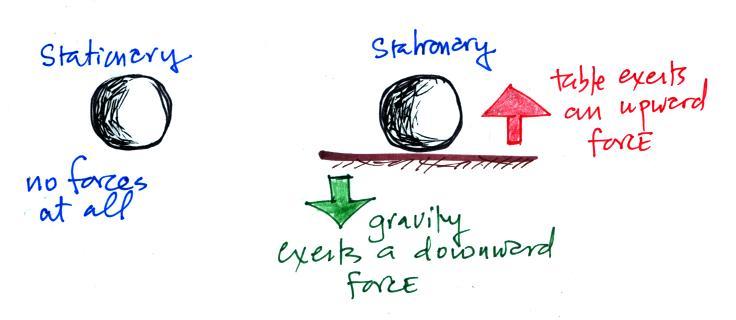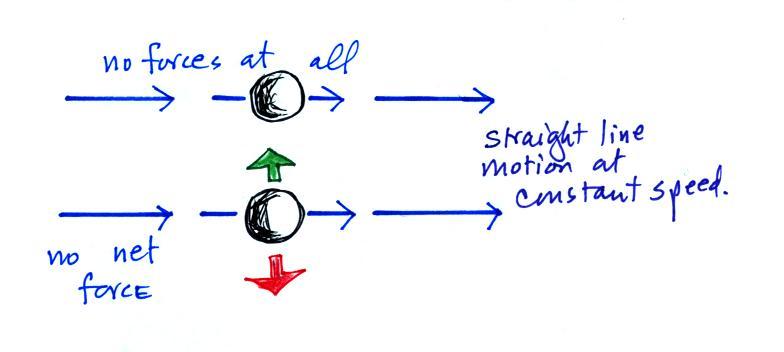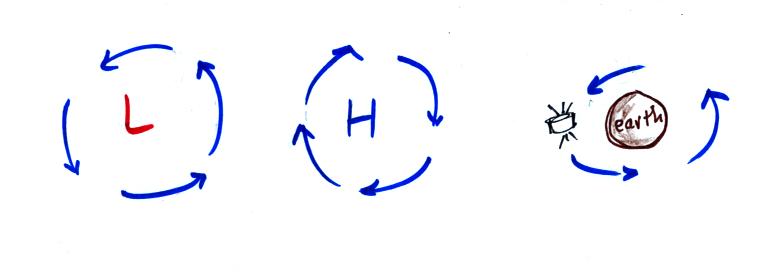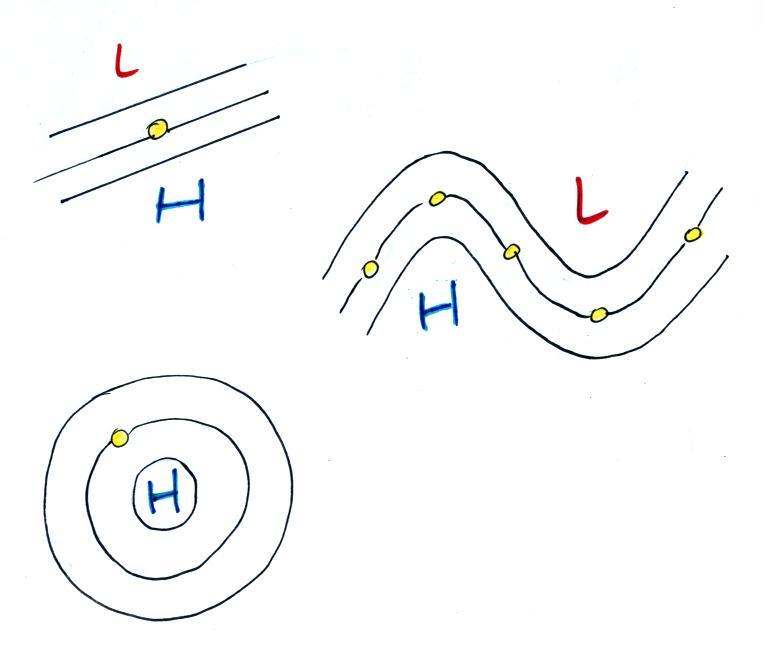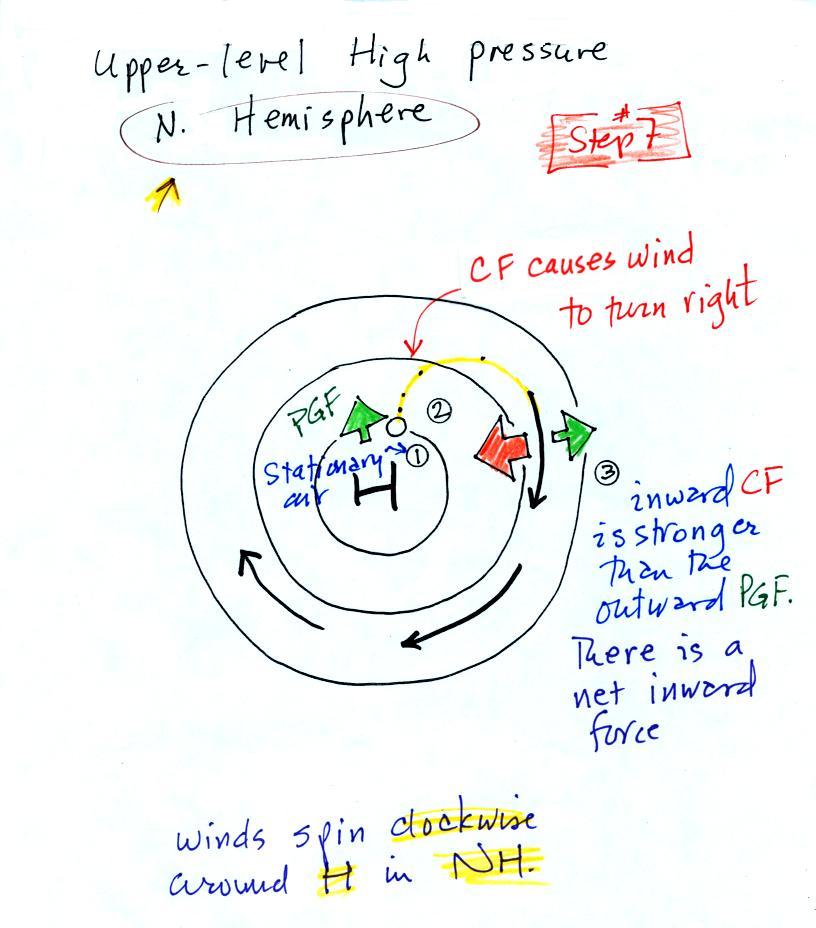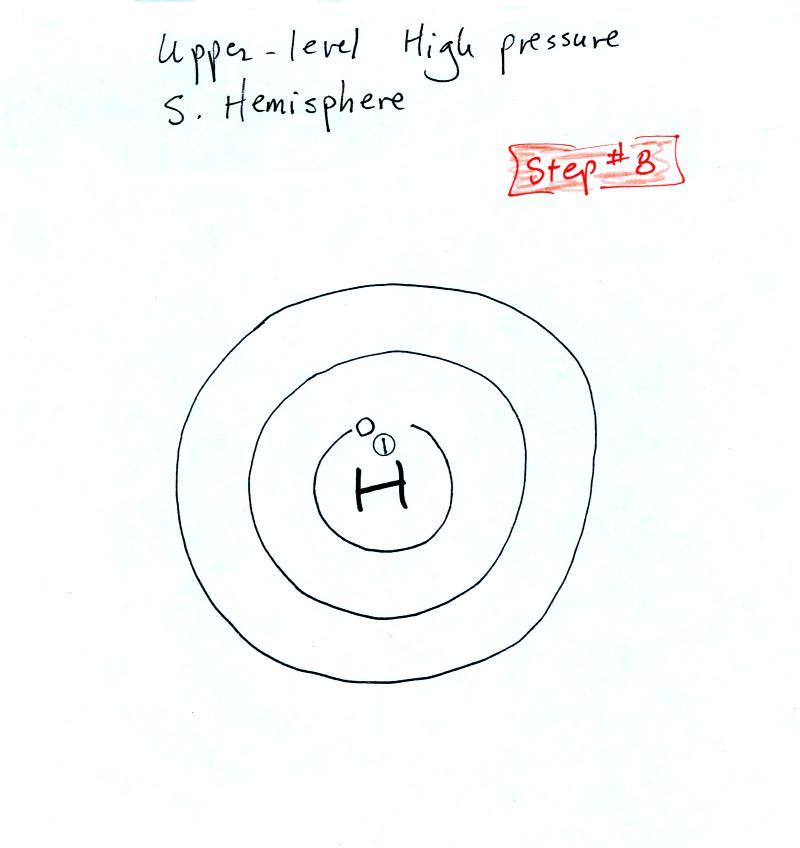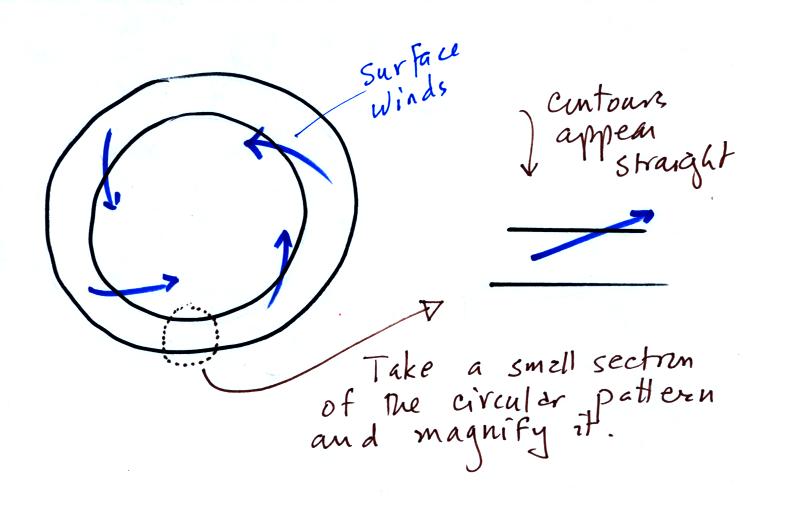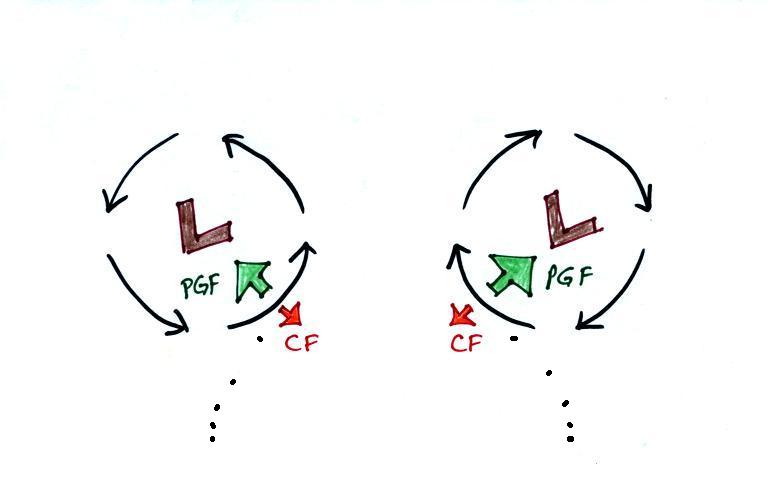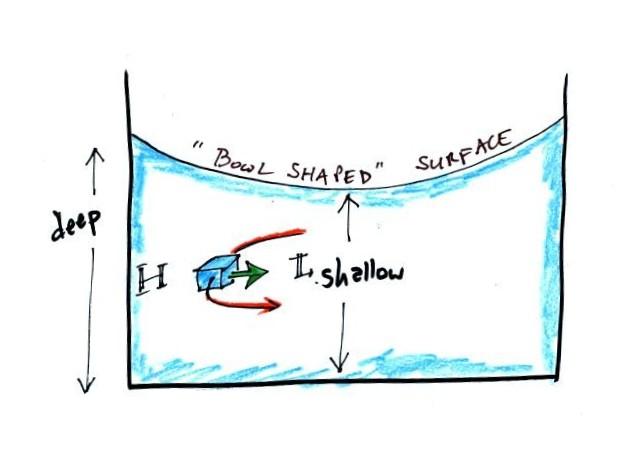Tuesday Nov. 6, 2012
Some surf guitar from Dick Dale ("Peter Gunn", "Esperanza", and "Misirlou") for
Election Day.
Quiz #3 has been graded and was returned in class today.
The Experiment #1 revised reports have finally been graded. Click
here to see if you have an experiment (or book) report waiting to be
picked up. I'm working hard on the Expt. #3 reports and hope to
be able to return them on Thursday.
I had hoped to have the 1S1P 1983 Flood reports graded by today but
have fallen a little behind. The Tucson Fog reports are due on
Thursday this week. You can also report on a new Foucault Pendulum topic.
Those reports are due one week from today.
An In-class
Optional Assignment was handed out today and collected at the end
of class. If you'd like to download the assignment and turn it in
at the start of class on Thursday you can earn at least partial
credit. There's also a take-home Optional Assignment that you'll
find embedded in today's notes.
We'll be covering a lot of topics in the next 3 weeks or so before
the last quiz of the semester: forces that cause the wind to blow the
way it does in the northern and southern hemispheres; thunderstorms,
tornadoes, and lightning; and hurricanes.
Today and Thursday we will be
looking
at how
and why
surface and upper level
winds blow the way they do.
Some real world examples of where
this occurs are shown in the figure
below (found on p. 121 in the ClassNotes). The two largest types
of storm systems, middle latitude
storms (extratropical cyclones) and hurricanes (tropical cyclones),
develop around surface centers of low
pressure. Winds
spin counterclockwise around cyclones (centers of low pressure) in the
northern hemisphere and
clockwise in the southern hemisphere.
Winds spin clockwise around
"anticyclones" (high pressure) in the northern hemisphere and
counterclockwise in the southern hemisphere.
Why do winds blow in opposite directions around high and low
pressure. Why do the winds change directions when you move from
the northern to the southern hemisphere. These are the kinds of
questions we'll be addressing.
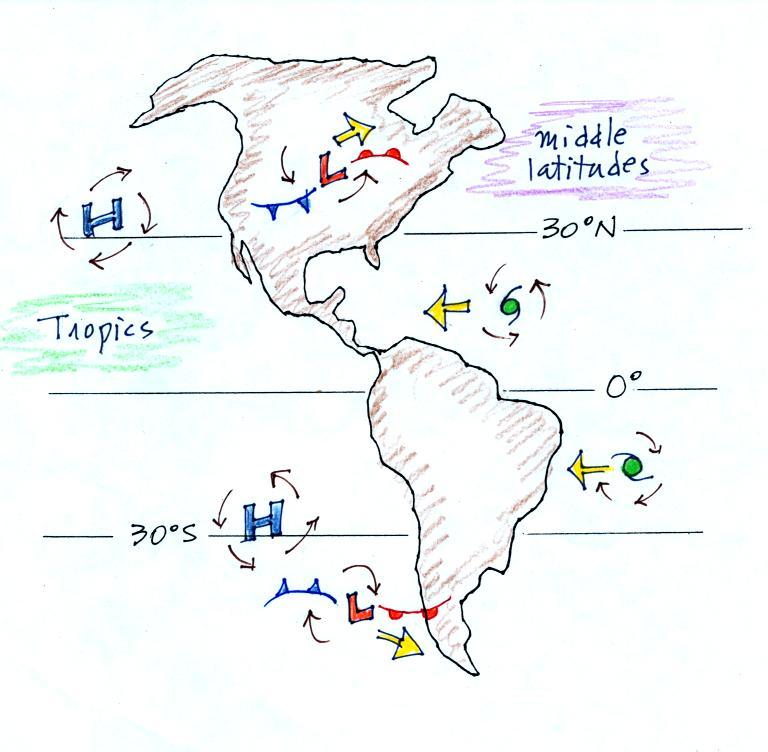
Storm systems in the tropics (0 to
30 degrees latitude) generally move
from east to west in both hemispheres. At
middle latitudes (30 to 60 degrees), storms move in the other
direction,
from west to
east. To understand why this is true we need to learn something
about the earth's global scale pressure and wind patterns. This
is a topic we will be getting into the middle of next week.
I've borrowed some more carefully
drawn figures below from a previous semester. Step #1 is found on
p. 122a in the
ClassNotes.

Upper level winds spinning around
high and low pressure in the
northern and southern hemispheres are shown in the first set of four
pictures. The first thing to notice is that upper level winds
blow parallel to the contours. Just 2 forces,
the
pressure gradient force (PGF) and the Coriolis force (CF), cause the
winds to blow this way. Eventually you will be able to
draw the directions of the forces for each of the four upper level
winds examples. Here is an
example
of what you will be able to do.
The four drawings at the bottom of the page show surface winds
blowing
around high and low pressure in the southern hemisphere. These
winds blow across the contour lines slightly, always toward low
pressure. The frictional force is what causes this to
occur. He is
an example of what you will be able to say about surface winds
blowing around low pressure in the southern hemisphere.

The two objects above are stationary. In both
cases there is no net force. At left there aren't any forces at
all. At right, forces are present but that cancel each other out
and the total or net force is zero. With zero net force both
objects will remain stationary.
Here an object is moving in a straight line at constant speed.
For this to be true the net force must be zero in both cases (otherwise
the object would speed up, slow down, or change direction). As
long as the net force remains zero both objects will continue to move
in a straight line at constant speed.
Another important point to take from Step #2
is that a net inward force is
needed anytime an object is moving in a circular path even if the speed
is constant. It doesn't
matter what direction the object is moving and it doesn't matter what
the object is circling around.
A net inward force is needed to keep winds spinning around a
center of low pressure, an inward force is needed to keep air moving in
a circular path around high pressure, and a net inward force (gravity)
is needed to keep a satellite in a circular orbit around the
earth. It wouldn't matter what direction the satellite is moving.
Now we'll
start to look at the forces that cause the wind to blow.
Pressure Gradient Force (PGF)
Air moving inward toward low
pressure or outward away from high pressure is similar to a rock
rolling down and away from the summit of a hill or inward toward the
bottom of a depression. The pressure gradient force always
points perpendicular to the contour lines on a map and toward low
pressure.
The PGF will cause stationary air to begin to move (it will always move
toward low
pressure).
Use the following figure (not shown in class)
to
test
yourself.
With an arrow draw the direction of the PGF at
each of the points in the figure. You'll find the answers at the
end of today's notes.
Coriolis
Force
The Coriolis force is caused by the
rotation of the earth. We'll learn more about what causes the
Coriolis force next Monday. The CF points
perpendicular to the wind and can only
change the wind's direction. It can't cause the wind to speed up
or
slow down. The direction of the CF depends on whether you're in
the northern or southern hemisphere.
Hurricanes don't form at the equator because there is no Coriolis
force there.
Time now to begin applying what
we've learned.
We start with some stationary air at Point 1. Because the air is
stationary, there is no Coriolis force. There is a PGF
force. The PGF at Point 1
starts stationary air moving toward the center of low pressure (just
like a rock would start to roll downhill).
Once the air starts to move, the CF causes it to turn to the right
(because this is a northern hemisphere chart). This is happening
at Point 2 (the dots show the initial motion of the air). As the
wind speeds
up the CF strengthens. The wind
eventually ends up at Point 3 blowing parallel to the contour lines and
spinning
in a
counterclockwise direction. Note that the inward PGF is stronger
than the outward CF. This results in a net inward force,
something that is needed anytime wind blows in a circular path.
See if you can figure out
what would happen with low pressure in the Southern Hemisphere.
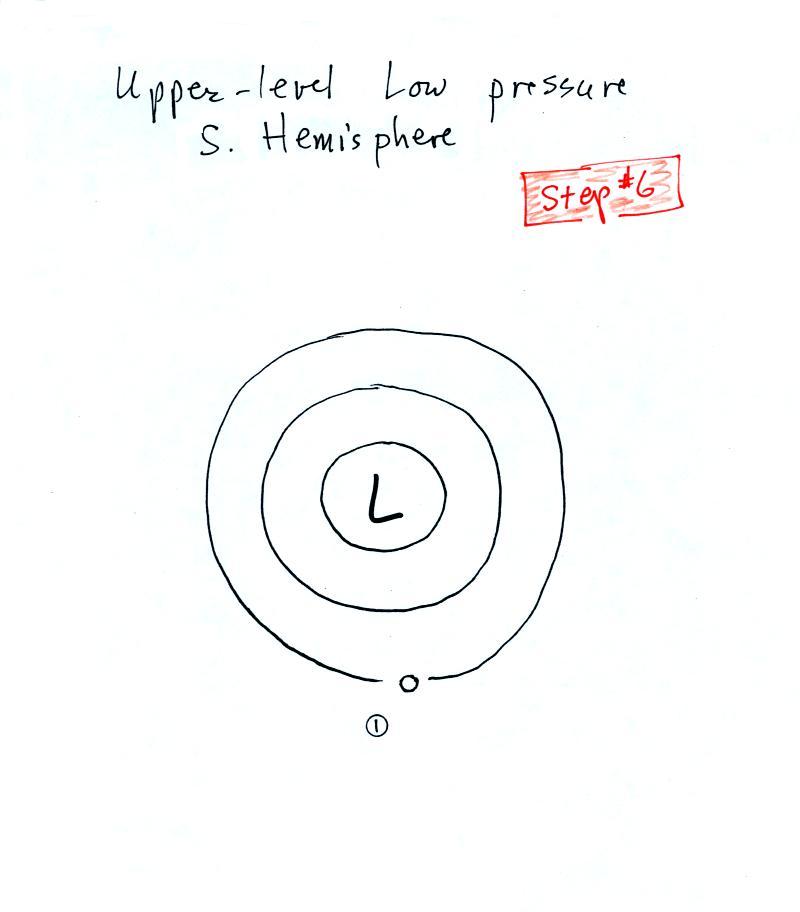
We start again with some stationary
air at Point 1 in this
figure. You'll find the answer at the end of today's notes.
Now what about upper level high pressure?
Here initially stationary air at
Point 1 begins to move outward in response to an outward pointing
pressure gradient force (PGF). Once the air starts to move, the
Coriolis force (CF) will cause the wind to turn to the right. The
wind ends up blowing in a clockwise
direction around the high. The inward pointing CF is a little
stronger than the PGF so there is a net inward force here
just as there was with the two previous examples involving low
pressure. An inward force is needed to keep anything moving in a
circular path.
This is a southern hemisphere upper level center of high
pressure. You should be able to figure out how the winds will
blow in this
case. You'll find the answer at the end of today's
notes.
Upper level winds blow parallel to the contour
lines. Now we'll try to understand why friction causes surface
winds to
blow across the contour lines (always toward low pressure).
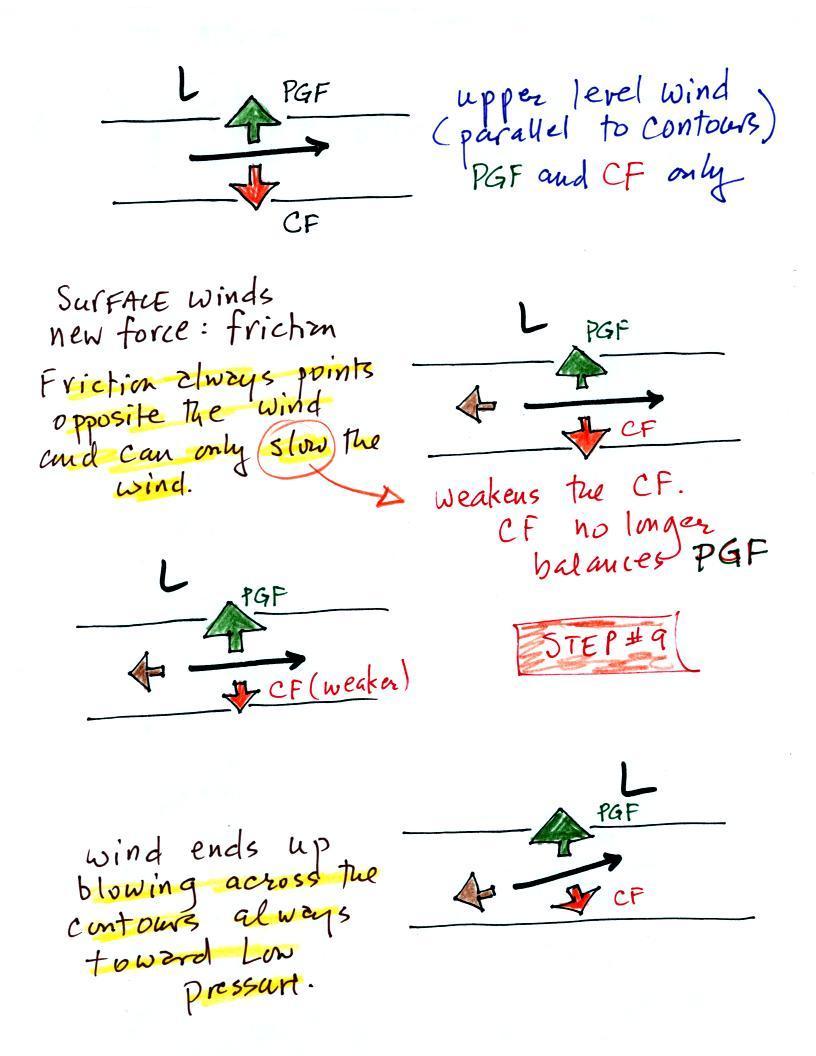
We add friction in the second picture. It points in a direction
opposite the wind and can only slow the wind down. The strength
of the frictional force depends on wind speed (no frictional force if
the wind is calm) and the type of surface the wind is blowing over
(less
friction when wind blows over the ocean, more frictional force when the
wind is blowing over land).
Slowing the wind weakens the CF and it can no longer balance the
PGF (3rd figure). The stronger PGF causes the wind to turn and
start to blow across the
contours toward Low. This is shown in the 4th figure.
Eventually the CF and Frictional force, working together, can balance
out the PGF. The net force would again equal zero and
the wind would blow in a straight line at constant speed acrosss the
contours toward low pressure.
What we've learned from the straight contour example, namely
that
the winds will blow across the contours toward low pressure can be
applied to a curved contour pattern. The figure below
wasn't shown in class.
If you take a small little piece of
a curved pattern and magnify it, it will look straight.
Now our last step, surface winds blowing around H and L in the NH
and SH.
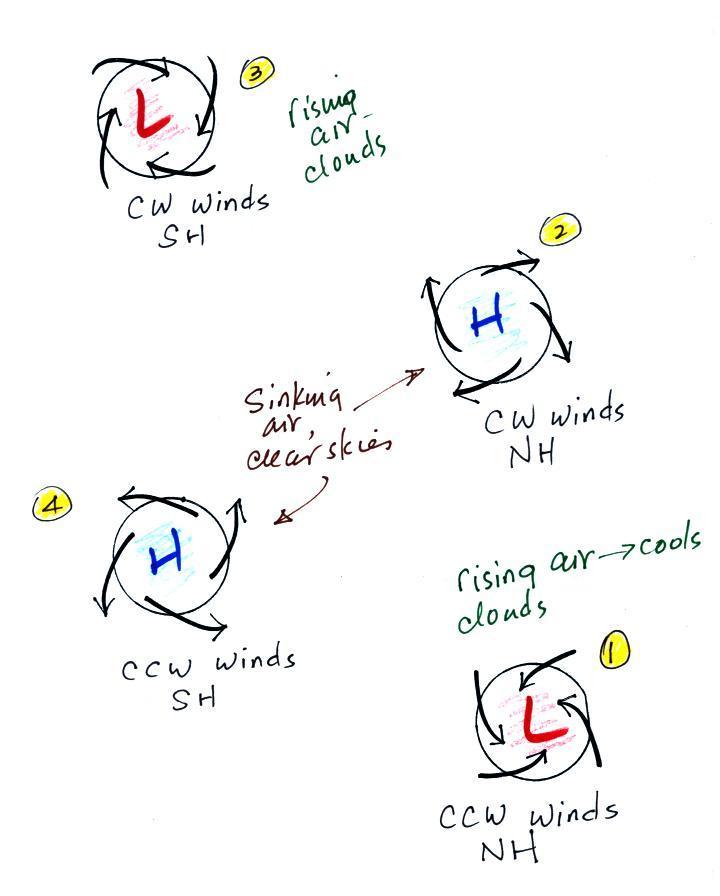
It is easy to figure out
which of
the figures are centers of
low pressure (the wind blows inward toward the center of the
picture) The winds are spiralling inward in the top and
bottom
examples (1 and 3).
These must be surface centers of low pressure. The winds are
spiraling outward from the centers of high pressure (2 and 4).
Now you probably don't want to figure out which of these are northern
and which are southern hemisphere pictures. It is probably best
to remember one of the pictures. Remember in 1, for example, that
surface winds spin
counterclockwise and spiral inward around centers of
low pressure in the northern hemisphere (something we learned
early in
the semester). Then remember that winds spin in the other
direction and blow outward around high pressure in the northern
hemisphere (2). The spinning directions of the winds reverse when
you move from the northern to the southern hemisphere. Thus you
find clockwise spinning winds and inward motion around low pressure (3)
and counterclockwise and outward spiraling winds around high pressure
in the southern hemisphere.
Converging winds cause air to
rise. Rising air expands and cools and can cause clouds to
form. Clouds and stormy weather are associated with surface low
pressure in both hemispheres. Diverging winds
created sinking wind motions and result in clear skies.
We had time, barely, for one more topic today.
There's a common misconception
involving the Coriolis force. You
might have
heard
that
water
spins
in
a
different
direction
when
it
drains from a sink or a toilet bowl in the southern hemisphere
than it does in the northern hemisphere. You might also have
heard that this is due to the Coriolis force or the Coriolis
effect.
The Coriolis force does
cause winds to spin in opposite directions around large scale high and
low pressure
centers in the northern and southern hemisphere. The
PGF starts the air moving (in toward low, out and
away from high pressure) then the Coriolis force bends the wind to the
right (N. hemisphere) or to the left (S. hemisphere).
Here's what you end up with in the case of low pressure (you'll find
these figures on p. 130 in the photocopied ClassNotes):
Air starts to move inward toward
low pressure (the dots show this initial motion). Then
the
Coriolis force causes it to turn to the right or left depending on
which hemisphere you're in. You should be able to say which of
the pictures above is the northern hemisphere and which is the southern
hemisphere picture.
The same kind of idea applies to
high
pressure except that the air starts moving outward (the dots
aren't included here). The Coriolis
force then turns it to the right or left.
There are situations where the PGF is much stronger
than
the
CF and the CF can be ignored.
A
tornado
is
an
example.
The
PGF
is
much
much
stronger
than
the
CF
and the CF can be
ignored.
Winds
can
blow
around
Low
pressure
because the PGF points inward.
The wind can
spin in either direction in either
hemisphere.
Note that without the CF, winds can't spin around High
pressure because
there is nothing to provide the needed inward force.
OK, what about water draining from
sinks, buckets, toilets etc.
There's just an inward pointing
PGF, no
CF. Water can spin in either direction in either
hemisphere. What causes the inward pointing PGF? The water
at the end of the spinning water is a little deeper than in the
middle. Since pressure depends on weight, the pressure at the
outer edge of the spinning water is higher than in the center.
This creates the inward pointing pressure gradient (pressure
difference) force.
Water draining from a sink or toilet can spin in
either direction. It doesn't matter where you're located.
But this something we should probably checkout for ourselves, so here
is one of my favorite
optional assignments of the semester.
Below are the answers to the
questions embedded in today's notes.
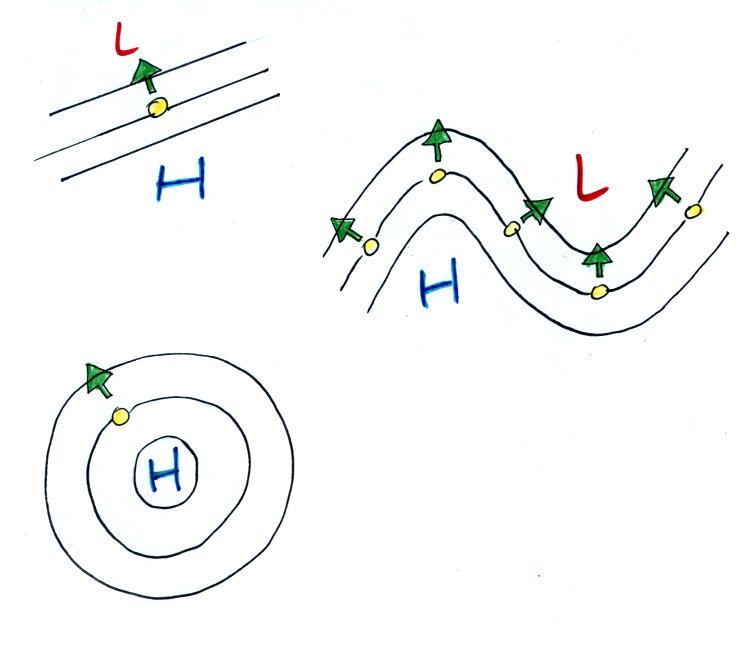
The stationary air starts to blow inward toward low
pressure. Then the Coriolis force causes the wind to turn to the
left. The wind ends up blowing in a clockwise direction around
Low pressure in the Southern Hemisphere.
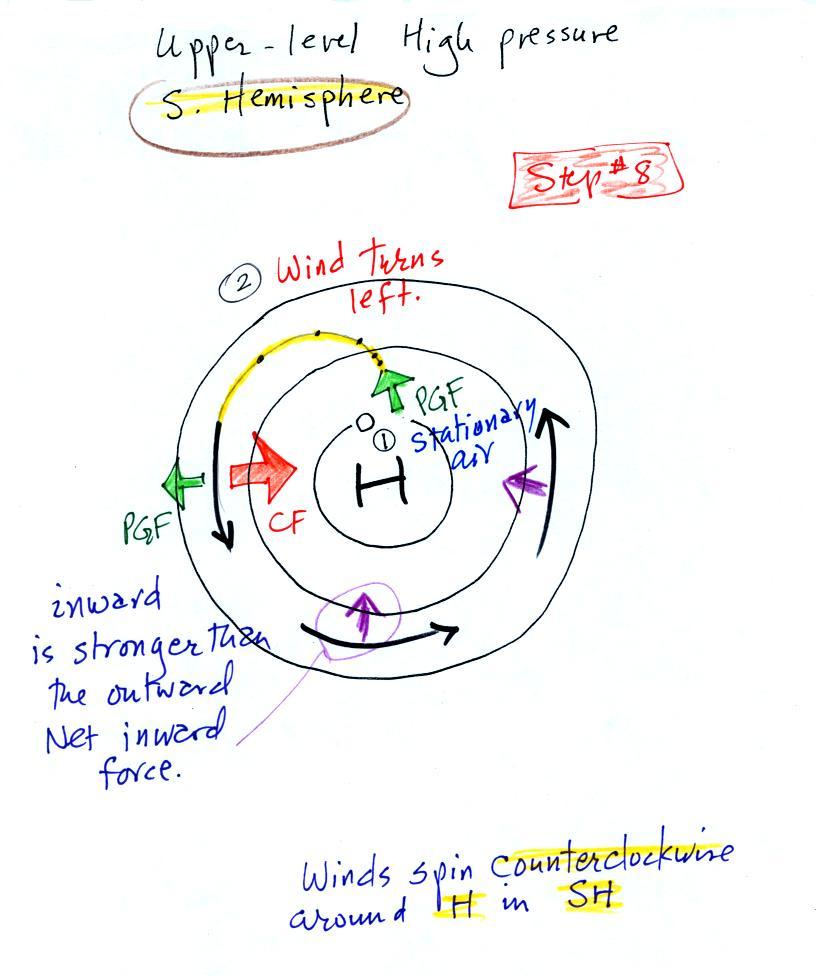
The air starts to move outward and
then turns to the left. Winds blow in a counterclockwise
direction around high pressure in the southern hemisphere.




